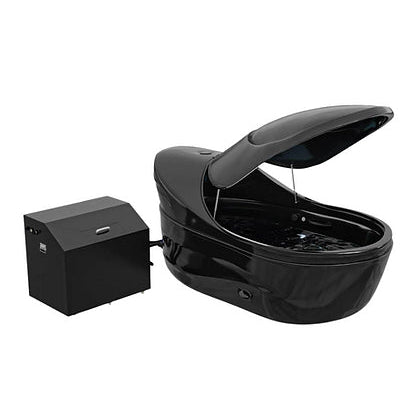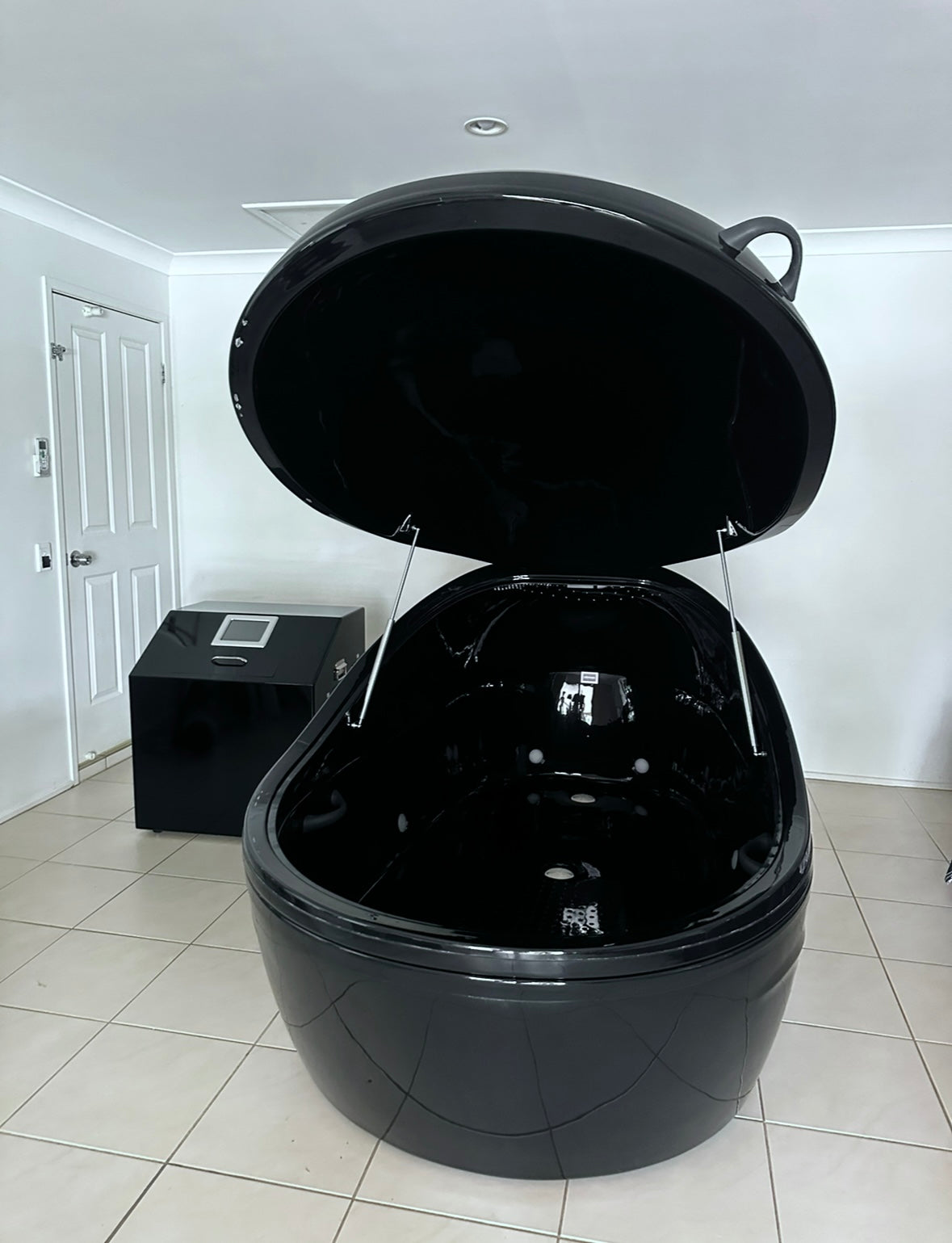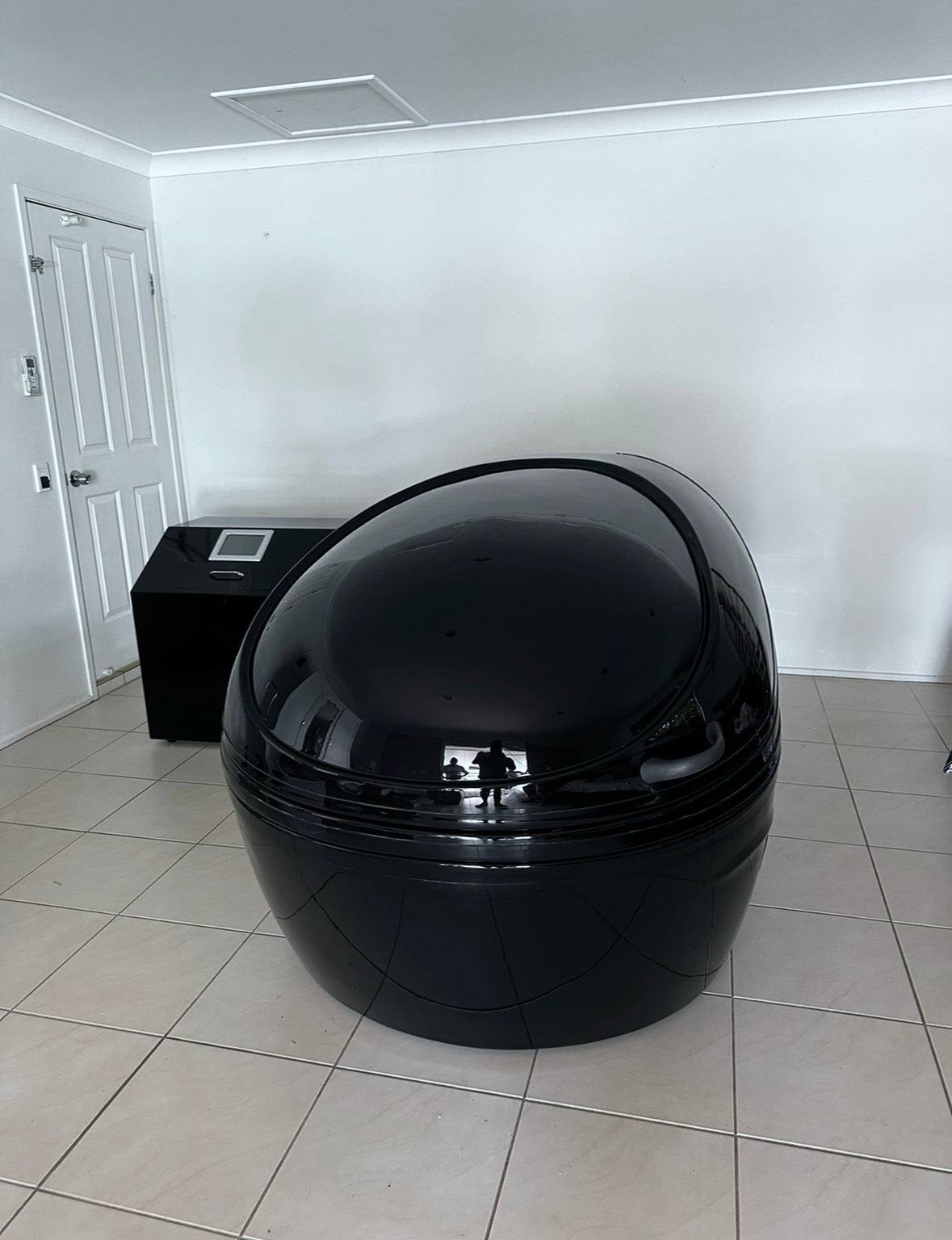Salt Float Pod
Share

Collapsible content
Specifications
Temperature
Temp Range: 25 - 70 °C
Measurements
2500*1505*1300
950kg when filled
Features
- Acryclic Material
- Timer Range: 0-999min
- Disinfection Pod by Ozone 03
- Automatic Water Recyling
- Bluetooth Music
- UV Disinfection Light
- Gas Strut
Power
Wattage: 6000w
Voltage: 220-240v
Electrician Required? Yes, if no 15amp wall socket is available. Also required is a 25amp circuit breaker installed in the meter box.
Operating Costs
The operating cost of this float tank is approximately $1.50 per hour
Warranty
1 Year Warranty
FAQ
What is a salt float tank? A salt float tank is a dark, soundproof tank filled with a shallow solution of warm water and Epsom salt (magnesium sulfate). The high salt concentration allows users to float effortlessly, creating a unique experience of weightlessness and sensory deprivation.
What are the benefits of using a salt float tank? Benefits include relaxation, stress relief, pain relief, improved sleep, enhanced creativity, and potential meditation benefits. Many users report feelings of deep relaxation and mental clarity.
How long should I float in a tank?Sessions typically last between 60 to 90 minutes. However, beginners might want to start with shorter sessions and gradually increase the duration as they become more comfortable.
Is it safe to float in a salt tank?Yes, floating in a salt tank is generally safe for most people. However, individuals with certain medical conditions (like severe skin issues or claustrophobia) should consult with a healthcare provider before trying it.
What should I expect during a float session?Expect to enter a quiet, dark environment where you can float in warm water. Many people experience deep relaxation and may lose track of time. Some might feel sensations of floating or drifting.
What if I feel anxious or claustrophobic?It’s normal to feel some anxiety the first time. You can leave the tank at any time. Many tanks also offer the option to keep the door open or use a larger tank if available.
How often should I float? The frequency can vary based on personal preference and goals. Some people float weekly, while others may float monthly or less frequently.
What should I wear during a float session?Most people float nude to avoid any discomfort from clothing. However, you can wear a swimsuit if you prefer. It's essential to follow the guidelines provided by the facility.
Is the water in the tank clean? Yes, float tanks are usually equipped with filtration systems that clean the water between sessions. Facilities follow strict hygiene protocols to maintain water quality.
Can I float if I’m pregnant? Many pregnant individuals find floating beneficial for relaxation and pain relief. However, it's advisable to consult with a healthcare provider before trying it.
What if I have a skin condition? If you have open wounds or severe skin conditions, consult your doctor before floating, as the saltwater may irritate sensitive areas.
Returns
Hassle-Free Returns
Enjoy a 30-Day Return Policy!
If you're not completely satisfied with your purchase, simply return it within 30 days for a full refund.
Customer & Technical Support
At Boketto we prioritize your experience with our products. That's why we offer dedicated customer and technical support during business hours. Our knowledgeable team is here to assist you with any questions or concerns you may have.
For those in the Gold Coast area, we provide in-person tech support, ensuring you receive hands-on assistance tailored to your needs. Whether you need help setting up your product or troubleshooting an issue, our local experts are just a visit away. Your satisfaction is our top priority!
Maintenance
Maintaining a salt float tank, or flotation therapy tank (often called a sensory deprivation tank or isolation tank), requires regular cleaning, water quality management, and routine inspections to ensure a safe, hygienic, and effective float experience. Here's a breakdown of the key maintenance tasks:
1. Water Filtration & Sanitisation:
Daily (or after each float session):
Water Filtration: The filtration system should run continuously between sessions to maintain cleanliness. Our float tanks have a high-quality filtration system that typically cycles the water for several hours after each session.
UV Light or Ozone Treatment: Most tanks have UV or ozone sanitizers that kill bacteria, viruses, and fungi. Ensure these are functioning properly.
Weekly:
Check Chemical Balance: Maintain proper water chemistry by testing pH, alkalinity, and salinity levels. The salt content in float tanks is very high (about 450 kg of Epsom salt in 750 litres of water). It’s crucial to monitor:
pH Level: Should be between 7.5–8.5 for comfort and hygiene.
Salinity: Keep the salt concentration at the recommended level to ensure buoyancy (about 30% salt).
Chlorine or Bromine Levels: Even though float tanks are filled with high salinity water, a small amount of chlorine or bromine is often added for additional disinfection.
Inspect UV or Ozone Systems: Ensure that your UV light or ozone generator is working efficiently.
2. Water Change and Deep Cleaning:
Every 6 Months:
Complete Water Change: Replace the water entirely, especially if the tank is used frequently. This ensures that the water remains free of contaminants that the filtration system may miss.
Deep Clean the Tank: Wipe down all surfaces, including the tank's walls and floor, with a non-abrasive cleaner that is safe for both the tank’s material and its water. Use a disinfectant that is non-toxic and safe for skin contact. Replace filter.
3. Maintenance of the Tank’s Interior:
Monthly or As Needed:
Check the Interior Surface for Damage: Inspect the walls and floor for any cracks or wear and tear that could result in leaks.
Clean the Tank Lid and Surroundings: Ensure that the lid and surrounding areas (e.g., control panel, exterior) are clean and sanitised.
4. General System Checks:
Monthly:
Inspect Heating System: The water is kept at a temperature around 94-96°F (34-35°C). Regularly check that the heating system is functioning properly.
Check Pumps and Jets: Ensure all pumps and jets are working efficiently.
Examine the pH/Salinity Sensors: Calibration may be necessary to ensure the water chemistry is accurate.
5. General Hygiene and Hygiene Protocols:
After Every Float:
Encourage customers to rinse off before entering the tank to minimise contaminants entering the water. Provide customers with clean, dry towels and instructions on maintaining cleanliness.
6. Check for Malfunctions or Wear:
Routine Checks: Regularly check for any issues with the lighting, audio system, ventilation, and other features of the tank.
Keep a Maintenance Log: Record all maintenance activities, water quality checks, and issues for better tracking and to spot trends or recurring problems.
7. General Tips:
Salt Build-up: Over time, salt crystals can build up around the tank's edge or on the filtration equipment. These should be cleaned off regularly to prevent clogging or damage.
Professional Maintenance: It's recommended to have a professional inspect your tank annually or semi-annually, especially if it's in heavy use, to ensure everything is in top condition.
By following these steps and maintaining a consistent cleaning and testing schedule, you'll ensure a clean and safe environment for those using the flotation tank while also extending the life of the equipment.



